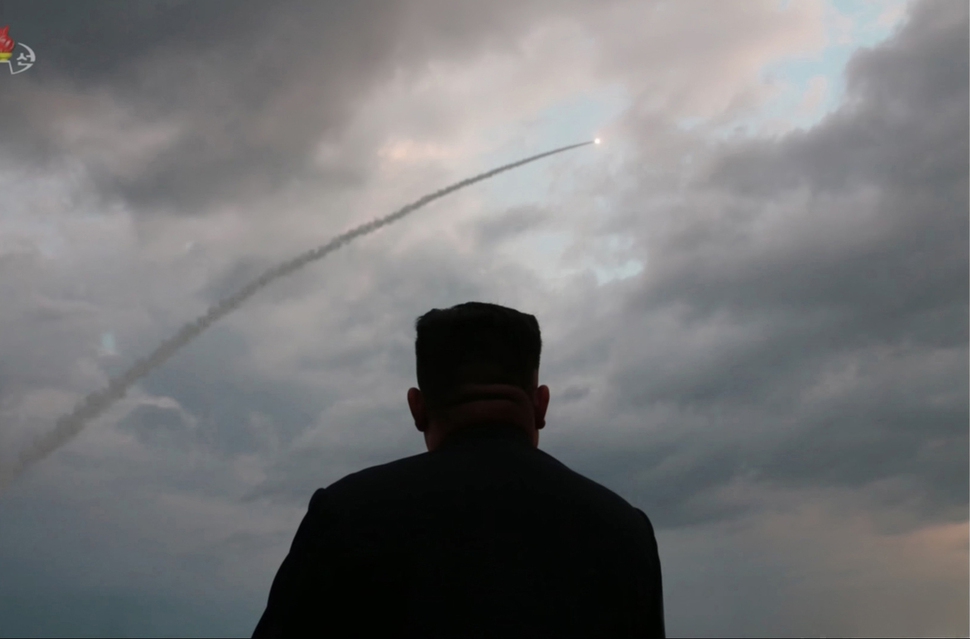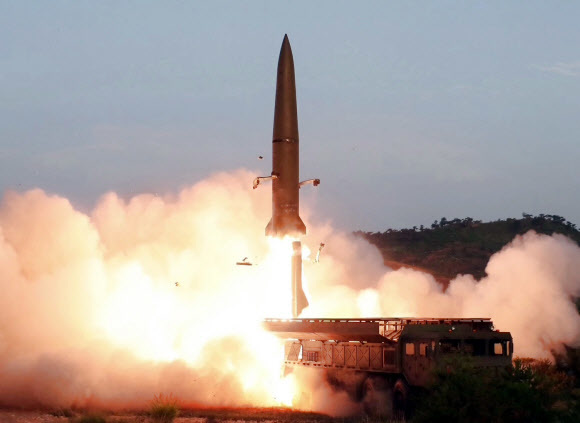Posted on : Aug.7,2019 16:56 KST
Modified on : Aug.7,2019 17:12 KST
 |
|
An image of North Korean leader Kim Jong-un overseeing the test launch of a missile on July 31, published by the Korean Central News Agency on Aug. 1. (Yonhap News)
|
On Aug. 6, North Korea once again launched what are presumed to be short-range ballistic missiles — the fourth time it has done so since July 25. The launch appears to have had multiple motivations: protesting South Korea and the US’ movement toward joint military exercises, boosting its bargaining position in upcoming negotiations with the US, and shoring up domestic support for its regime. But missile launches are provocative actions that raise military tensions not only on the Korean Peninsula but also across Northeast Asia. North Korea needs to immediately desist from such risky behavior.
According to information released by South Korea’s Joint Chiefs of Staff, two projectiles that appear to be ballistic missiles were fired toward the east from a North Korean base in Kwail County, South Hwanghae Province, early in the morning on Aug. 6. The projectiles flew a distance of 450km, and their flight characteristics were reportedly similar to those of the KN-23 new short-range ballistic missile that was launched on July 25.
“In the end, American and South Korean officials are pushing ahead with their joint military drills that are targeted at us. [In that case,] we may be forced to explore a new path,” North Korea threatened in a statement signed by a Foreign Ministry spokesperson. These comments show that the projectile launch was made in preemptive retaliation for the South Korea-US military exercises, whose schedule will reportedly be announced while US Secretary of Defense Mark Esper is visiting South Korea on Aug. 9.
 |
|
North Korea launched what’s assumed to be a short-range ballistic missile on Aug. 6. The projectile bears similar flight patterns to the missile it test launched on July 25. (Yonhap News)
|
But the fact is that the South Korea-US joint military exercises are being conducted to assess the South Korean military’s capabilities as part of a process of Seoul regaining wartime operational control of its armed forces, and South Korean and US authorities have said that the exercise is not a rehearsal of an invasion of North Korea, as the North claims. Furthermore, the past few weeks have been a time of great anxiety in East Asian affairs, with Chinese and Russian aircraft carrying out joint drills and making an incursion into South Korean air space near Dokdo, the US hinting that it could deploy intermediate-range missiles in Northeast Asia, and the trade conflict simmering between South Korea and Japan. North Korea’s actions only aggravate that anxiety. And if the North Korean projectiles were in fact ballistic missiles, that also represents a violation of UN Security Council resolutions that ban all ballistic missile launches.
Instead of ratcheting up military tensions by firing missiles, North Korea ought to be actively joining negotiations and dialogue aimed at denuclearization. Even though the leaders of the US and North Korea met at Panmunjom at the end of June and agreed to resume working-level talks within two or three weeks, there are still no clear indications that talks will resume. While it isn’t certain which side is responsible for the delay, a missile launch isn’t a typical behavior for a country gearing up for negotiations. Perhaps it can be seen as an attempt to psych out the other side before beginning talks, but four launches in two weeks is really taking things too far. North Korea needs to stop committing missile provocations. Now is the time for Pyongyang to show that it’s committed to the denuclearization talks.
Please direct comments or questions to [english@hani.co.kr]










